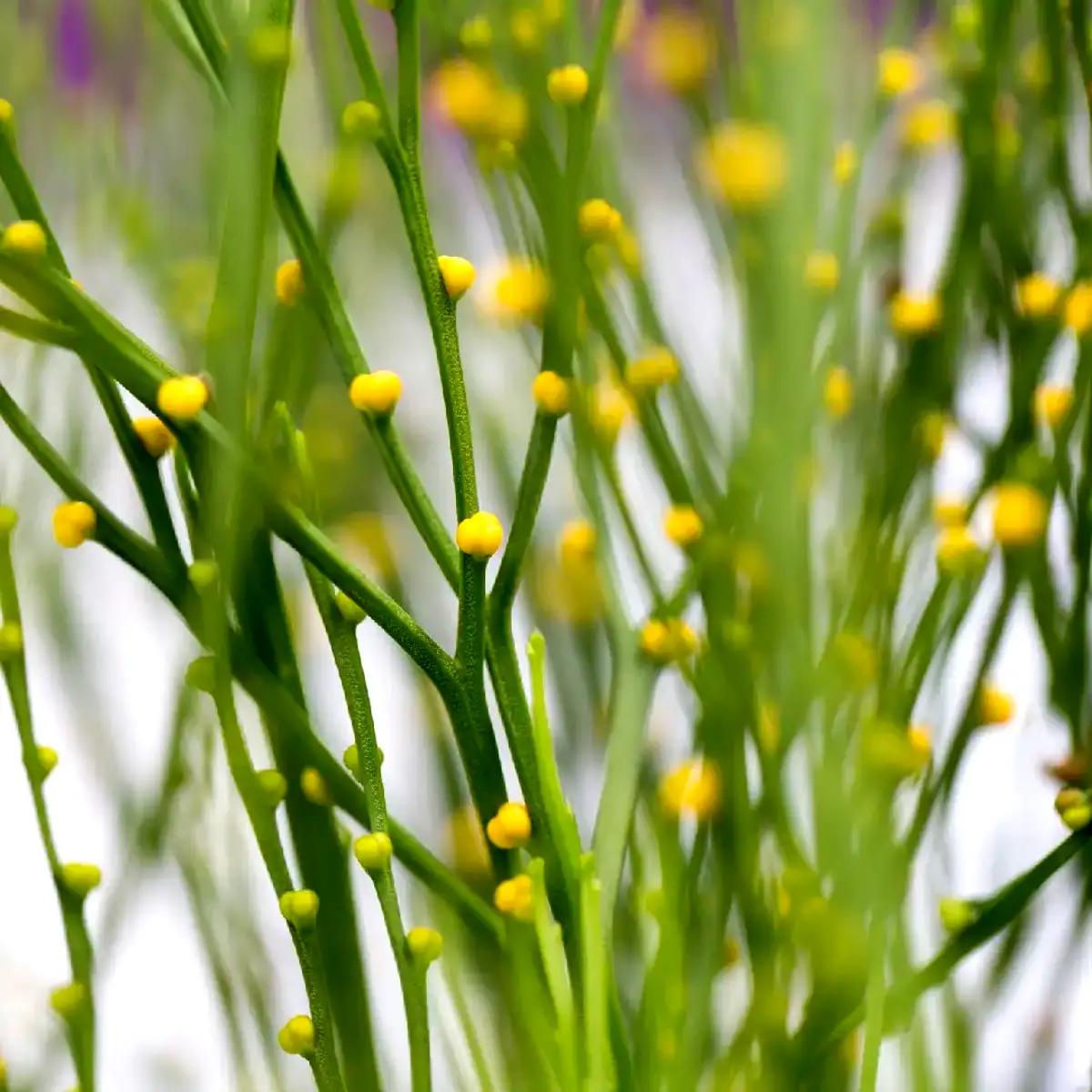Contents
CLASSIFICATION OF PSILOTUM
Kingdom :- Plantae
Division :- Pteridophyta
Sub-division :- Psilotopsida
Class :- Polypodiopsida
Order :- Psilotales
Family :- Psilotaceae
Genus :- Psilotum
EXTERNAL FEATURES OF PSILOTUM
- The plant body may be pendent or erect and dwarfed (about 8 cm high) or may reach a height of 75-100 cm.
- It is differentiated into
- A basal rhizomatous system
- Aerial branches.
- Basal rhizomatous system is subterranean, brown and rootless. The rhizome is repeatedly dichotomously branched and remains covered by small scales. The rhizome bears aerial “branches.
- Aerial shoots may be pendent (epiphytic species) or erect (terrestrial species). The slender and green aerial system is freely and dichotomously branched. The basal part of the shoot is cylindrical with longitudinal ribs. The distal green portion is radially cylindrical with three longitudinal ribs.
- Aerial shoots bear many, small and scale-like, irregularly distributed scale leaves.
- Sporangia are borne in triads (synangium) on very short stalks in axil of leaves (bifid), mostly towards the tip of the aerial branche
ANATOMY OF THE RHIZOME OF PSILOTUM
- The transverse section is almost circular in outline.
- It shows three distinct regions-epidermis, cortex and stele.
- The cuticularised epidermis consists of rectangular or square cells, not much different from the underlying cells. The cells are slightly thick on their outer tangential faces.
- The cortex is divisible into three regions-
- Outer: The cells are thin walled and parenchymatous contammg the hyphae of endophytic mycorrhiza.
- Middle : The cells are thin walled and parenchymatous with abundant starch grains.
- Inner : The cells are small, thin walled and parenchymatous. These are coloured brown due to the presence of tannins.
- Endodermis separates cortex from the stele. The cells are radially elongated and bear distinct casparian strips.
- The centrally located stele is a protostele. It remains enclosed by a pericycle situated next to the endodermis. Pericycle is single layered and parenchymatous
- In the centre of the stele is a solid xylem strand, consisting of a few tracheids (the number andlobes of xylem vary with the age of rhizome. In young condition only 2-3 tracheids and a solid strand is present while in mature rhizome, number of tracheids increases and core becomes progressively lobed). The distinction between metaxylem and protoxylem elements is not clear.
- The phloem extends from the xylem strand upto the pericycle thus completely surrounding the xylem strand.
ANATOMY OF AERIAL SHOOT OF PSILOTUM
- The transverse section appears slightly triangular in outline.
- It is shows three distinct regions-epidermis, cortex and stele.
- The epidermis consists of single layered, rectangular cells. The outer tangential walls are heavily cutinised and covered by a definite cuticle. Stomata are slightly sunken and are situated mainly in areas between the longitudinal ribs.
- Internal to the epidermis is a broad cortex distinguishable into three zones-outer, middle and inner.
- Outer cortex-the photosynthetic region, about 2-5 cells broad, is composed of vertically elongated cells and with small intercellular spaces. These cells contain numerous small chloroplasts.
- Middle cortex. This zone is made of thick walled cells. The cells are sclerenchymatous and become progressively thinner towards inner zone.
- Inner cortex is many celled broad, parenchymatous and contain numerous starch grains progressively towards centre.
- Endodermis separates stele and cortex. The cells of the endodermis are tangentially elongated and exhibit distinct casparian strips on the radial end walls.
- The stele is actinostelic, generally with six lobes. Each lobe has a few protoxylem elements at the tip while metaxylem is situated at its base.
- The lobes of xylem are surrounded by phloem which extends upto the endodermis. (Typical sieve tubes are said to be absent).
- Centre of the xylem is occupied by thick walled sclerenchymatous fibres with simple pits on their walls.
ANATOMY OF LEAF OF PSILOTUM
- The leaf is divisible into (i) epidermis, (ii) cortical tissue and (iii) a small leaf trace if present.
- The epidermis consists of thin walled cells while the rest of the foliar appendage is filled by photosynthetic tissue.
- A leaf trace ends into the base of foliar appendage (e.g. P. jlaccidium), however, in P. nudum there is no vascular bundle.
SPORE PRODUCING ORGAN THE SPORANGIUM OF PSILOTUM
- Sporangia, the spore producing organs, are produced on the aerial branches.
- These are borne in triads on minute appendages subtended by a bract. (Since the sporangia are fused with one another, the structure is called as synangium).
- In a transverse section, synangium reveals 4-5 layered jacket, outer of which is made of thick walled cells. The loculi are filled with numerous spores. Interspersed among the spores are disintegrated sporocytes which serve as nutritional fluid.
- Individual spores are bean-shaped or bilaterally symmetrical. The wall pattern is reticulate. There is a narrow slit with a median ridge.
GAMETOPHYTE OF PSILOTUM
- Gametophyte is subterranean and colourless. It is saprophytic and lives through the medium of symbiotic phycomycetous fungi.
- Gametophytes are irregularly cylindrical and once or twice dichotomously forked. Rhizoids are also given out.
- Gametophytes are homothallic. Sex organs are scattered over the entire surface. Archegonia are more in number than antheridia (or otherwise).
IDENTIFICATION OF PSILOTUM
- DIVISION – Pteridophyta
- True roots generally present (except in Psilopsida),
- True vascular strand present.
- Sub-division:- Psilotopsida
- True roots absent.
- Shoot differentiated into subterranean rhizome and aerial portion.
- Sporangia borne terminally.
- Order– Psilotales
- Sporophyte dichotomously branched.
- Sporangia generally borne singly,
- Stele protostele. generally actinostele.
- Eusporangiate and homosporous.
- Family – Psilotaceae
- Axis branched
- Scale leaves small and minute
- Genus – Psilotum
- Sporangia borne in triads (synangium).


Leave a Reply